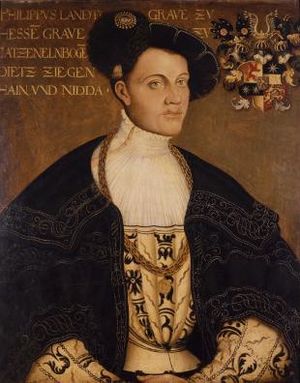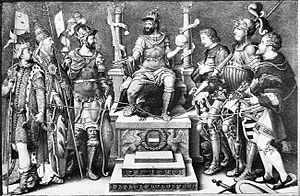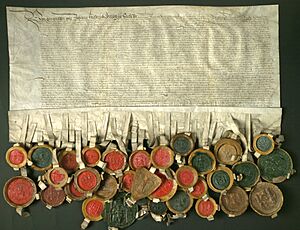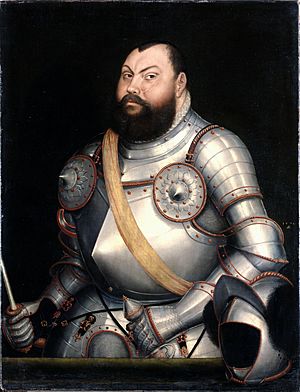Schmalkaldic League facts for kids
The Schmalkaldic League was a group of Lutheran princes and cities in the Holy Roman Empire during the mid-1500s. It was a military alliance, meaning its members promised to help each other if they were attacked. The League got its name from the town of Schmalkalden in what is now Germany.
Even though it started for religious reasons, the League's members later hoped it could become a new center for their political loyalty, replacing the Holy Roman Empire. Unlike earlier groups, the Schmalkaldic League had a strong army to protect its beliefs and interests.
Contents
How the League Started

The Schmalkaldic League officially began on February 27, 1531. It was formed by Philip I, Landgrave of Hesse, and John Frederick I, Elector of Saxony. These two were the most powerful Protestant leaders in the Holy Roman Empire at that time.
The League was created as a way to defend their religion. Members promised to protect each other if Emperor Charles V attacked their lands. To join, members had to agree with the Lutheran Augsburg Confession or the Reformed Tetrapolitan Confession.
Peace Agreement in Nuremberg
The formation of the Schmalkaldic League in 1531, along with a threat from Sultan Suleiman the Magnificent and his large army, made Ferdinand of Austria agree to a religious peace.
Ferdinand had been trying to make peace with Suleiman. As Suleiman's army got closer, Ferdinand finally agreed to the peace that Protestants wanted. This peace was made on July 23, 1532, in Nuremberg.
Those who supported the Reformation were given religious freedom. Also, all legal cases about religion in the imperial court were temporarily stopped.
The League Grows Stronger
In December 1535, the League allowed anyone who agreed with the Augsburg Confession to join. Many new members joined, including Anhalt, Württemberg, and Pomerania. Important cities like Augsburg, Frankfurt am Main, and Free Imperial City of Kempten also became part of the alliance.
In 1538, the Schmalkaldic League made an alliance with Denmark-Norway, which had recently become Protestant. By 1545, the Electoral Palatinate also joined the League under Frederick III, Elector Palatine.
In 1544, Denmark-Norway signed a treaty with the Holy Roman Empire. This treaty said that Denmark-Norway would remain peaceful towards the Empire. The League also received some support from Brandenburg. However, during the later war, Brandenburg's leader sent cavalry to help the Emperor instead of the League.
What the League Did
The members of the League agreed to provide a large army for their shared protection. They promised 10,000 foot soldiers and 2,000 horsemen. They usually did not directly challenge Emperor Charles V. However, they did take over church lands, removed Catholic bishops and princes, and helped spread Lutheranism across northern Germany.
Martin Luther, a key leader of the Reformation, planned to present a stricter Protestant statement of faith, called the Smalcald Articles, to the League in 1537.
Luther attended the important meeting in 1537. He was sick with kidney stones for most of the time. The rulers and princes even met at the house where Luther was staying. Although Luther prepared the articles, they were not officially adopted at that meeting. However, in 1580, they were included in the Book of Concord, an important collection of Lutheran beliefs.
The Political Situation
For 15 years, the Schmalkaldic League faced no major opposition. This was because Emperor Charles V was busy fighting wars with France and the Ottoman Empire. These wars, known as the Ottoman–Habsburg Wars, lasted for many years.
In 1535, Francis I of France supported the Protestant princes. He did this even though he was persecuting Protestants in his own country. He saw the Protestant princes as allies against their common enemy, Emperor Charles.
This support from France ended in 1544 with the Treaty of Crépy. In this treaty, the French king promised to stop helping the Protestant princes and the League in Germany.
In 1535, Charles V led a successful attack on Tunis. To limit Charles's power, Francis I allied with Suleiman the Magnificent of the Ottoman Empire. This alliance was known as the Franco-Ottoman alliance. The war between France and the Holy Roman Empire ended in 1538 with a truce.
The last war Charles fought against France during this period ended with no clear winner.
After making peace with France, Charles V signed a truce with the Ottoman Empire in 1547. This freed up more of his forces to finally confront the Schmalkaldic League.
The Schmalkaldic War

After making peace with France, Charles V focused on stopping Protestant resistance in his empire. From 1546 to 1547, Charles and his allies fought the League in what is called the Schmalkaldic War.
Even though the League's army might have been stronger, its leaders could not agree on battle plans. On April 24, 1547, Charles's forces defeated the League's army at the Battle of Mühlberg. Many leaders were captured, including John Frederick the Magnanimous. Philip of Hesse tried to negotiate, but the emperor refused. Philip surrendered in May.
This victory effectively won the war for Charles. Only two cities continued to resist. Many Protestant leaders, like Martin Bucer, fled to England. They had a direct impact on the English Reformation there.
What Happened Next
In 1548, the victorious Charles V forced the Schmalkaldic League to agree to his terms, known as the Augsburg Interim. However, by the 1550s, Protestantism was too strong in Central Europe to be stopped by force.
A small Protestant victory in 1552 forced Charles to flee. His heir, Ferdinand, signed the Peace of Passau. This agreement gave some freedoms to Protestants. It ended Charles's hopes of having one religion throughout his empire.
Three years later, the Peace of Augsburg officially recognized Lutheranism in the Holy Roman Empire. It allowed princes to choose the official religion for their own lands. This was based on the idea of Cuius regio, eius religio, which means "whose realm, his religion."
See also
- Other Protestant leagues:
- League of Torgau (1526–1531), an early league of Protestant princes that came before the Schmalkaldic League
- Protestant Union (1608–1621), a league of Protestant states that fought against the Catholic League
- Heilbronn League (1633–1648), a league of Protestant German states supported by Sweden and France



